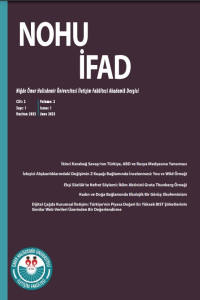THE WORLD OF METAVERSE IN THE MARKETING UNIVERSE OR THE WORLD OF MARKETING IN THE METAVERSE UNIVERSE?
Marketing, marketing communication, digitalization, metaverse.
THE WORLD OF METAVERSE IN THE MARKETING UNIVERSE OR THE WORLD OF MARKETING IN THE METAVERSE UNIVERSE?
Marketing, marketing communication, digitalization, metaverse.,
___
- Aguayo, C. (2017). AR/VR/MR & RR in Learning and Teaching Digital Projects, THETA (The Higher Education Technology Agenda) 2017 Conference, Type of Presentation: Present a Session, pp. 1-50.
- Ball, M. (2021). Framework for the Metaverse, The Metaverse Primer, MatthewBall.vc, https://www.matthewball.vc/all/forwardtothemetaverseprimer (Date of access: 13.06.2022).
- Cambridge Dictionary Translate Plus. (2022). Cambridge University Press, https://dictionary.cambridge.org/tr/translate/ (Date of access: 28.07.2022).
- Carmigniani, J. & Furht, B. (2011). Augmented Reality: An Overview. In Furht, B. (Eds) Handbook of Augmented Reality (pp. 3-46). New York: Springer, DOI: 10.1007/978-1-4614-0064-6_1.
- Foscht, T., Maloles, C., Swoboda, B., Morschett, D. & Sinha, I. (2008). The Impact of Culture on Brand Perceptions: A Six-Nation Study, Journal of Product and Brand Management, 17(3), 131-142.
- Laeeq, K. (2022). Metaverse: Why, How and What.https://www.researchgate.net/publication/358505001_Metaverse_Why_How_and_What/link/62053bb0afa8884cabd70210/download (Date of access: 10.08.2022).
- Kim, J. (2021). Advertising in the Metaverse: Research Agenda, Journal of Interactive Advertising, 21(3), 141-144.
- Kunkel, N. & Soechtig, S. (2017). Mixed Reality: Experiences get more Intuitive, Immersiveand Empowering (pp. 48-63). Lammerding: Deloitte University Press.
- MarketsandMarkets Research Private Ltd. (2022). Metaverse Market: Metaverse Market by Component (Hardware, Software (Extended Reality Software, Gaming Engine, 3D Mapping, Modeling & Reconstruction, Metaverse Platform, Financial Platform), and Professional Services), Vertical and Region - Global Forecast to 2027, https://www.marketsandmarkets.com/Market Reports/metaverse-market- 166893905.html?gclid=CjwKCAjwhNWZBhB_EiwAPzlhNmHXi_PRsWh hzHWmrS6n0g0w4oGmowo445YKHyv_ 7sGJHejHmGEjhoC_JQQAvD_BwE, (Date of access: 23.05.2002).
- Marr, B. (2021). Extended Reality In Practice: 100+ Amazing Ways, Virtual, Augmented And Mixed Reality Are Changing Business And Society. United Kingdom: John Wiley & Sons Ltd.
- McDonnell, J. & Drennan, J. (2010) Virtual Product Placement as a New Approach to Measure Effectiveness of Placements, Journal of Promotion Management, 16 (1-2), 25-38.
- Reportlinker.com (ReportLinker simplifies how Analysts and Decision Makers get industry data for their business). (2022). Metaverse Industry 2022: View Trends, Analysis and Statistics, Global Metaverse Industry 2022-2026, https://www.reportlinker.com/market-report/Advanced- IT/726665/Metaverse?term=metaverse%20market&matchtype=b&loc_inter est=&loc_physical=1012795&utm_term=metaverse%20market&utm_camp aign=transactionnel4&utm_source=google&utm_medium=ppc&hsa_acc=7 082072004&hsa_cam=15072279998&hsa_grp=138841791529&hsa_ad=59 5145580132&hsa_7&hsa_kw=metaverse%20market&hsa_mt=b&hsa_net= adwords&hsa_ver=3&gclid=CjwKCAjwhNWZBhB_EiwAPzlhNvz_rl9f2fJ BtVjn3QjKKqG0A9WkjzuvnpdiTImUEetuZz58EdVCxoCdnUQAvD_BwE (Date of access: 23.05.2002).
- Rosenberg, L. B. (2022). Marketing in the Metaverse: A Fundamental Shift, Future of Marketing Magazine, Future of Marketing Institute - Technical Report, August 15 (pp. 1-7). DOI: 10.13140/RG.2.2.35340.80003.
- Ünalan, D. (2020). Gazetecilikte Sanal Gerçeklik Uygulamaları: Immersive Journalism, in S. Gezgin & H. Çiftçi, İletişimde Seçme Konular I (pp. 415- 456). Ankara: İksad Yayınevi. VentureBeat (VentureBeat is an American technology website headquartered in San Francisco, California, It publishes news, analysis, feature features, interviews and videos). (2022). Metaverse 101 - Defining the Key Components. https://venturebeat.com/2022/02/05/metaverse-101-definingthe- key-components/29 (Date of access: 14.07.2022).
- Yadav, A. & Tomar, S. (2017). Virtual Reality: A Technology of Illusion, International Journal of Engineering Research & Technology (IJERT), Special Issue – 2017, ICADEMS - 2017 Conference Proceedings (pp. 1-6). ISSN: 2278-0181.
- Başlangıç: 2022
- Yayıncı: Niğde Ömer Halisdemir Üniversitesi
İŞÇİ SİNEMASI NASIL YAPILMALI? : EİSENSTEİN’IN GREV FİLMİ ÖRNEĞİ
MEDYANIN ETİK SORUMLULUĞU BAĞLAMINDA ÇOCUK SUÇLULUĞU HABERLERİ ÜZERİNE BİR İNCELEME
SİNEMADA MODÜLER ANLATI: KAYNAK KOD1 ÖRNEĞİ
YENİ MEDYA EKSENİNDE İDEOLOJİYİ ANLAMAK: FİLTRE BALONLARI VE YANKI ODALARI
СЕРИАЛ КИНОӨНІМІНІҢБҰҚАРАЛЫҚ ҚҰРАЛ РЕТІНДЕГІ ДАМУ ПРИНЦИПТЕРІ
